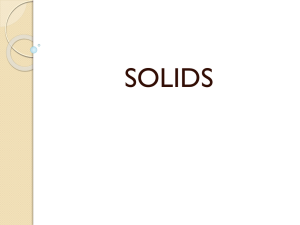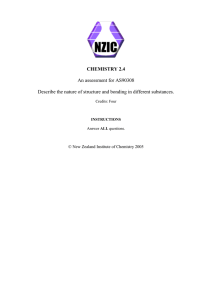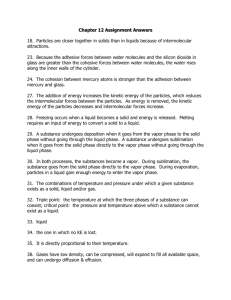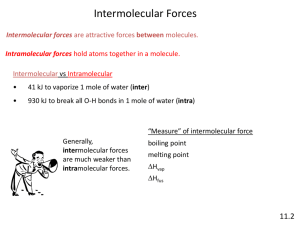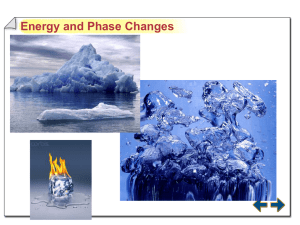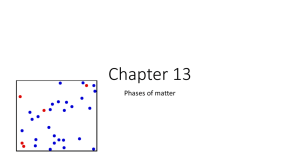AP Chemistry : Ch. 10 Notes Page 1 of 5
advertisement
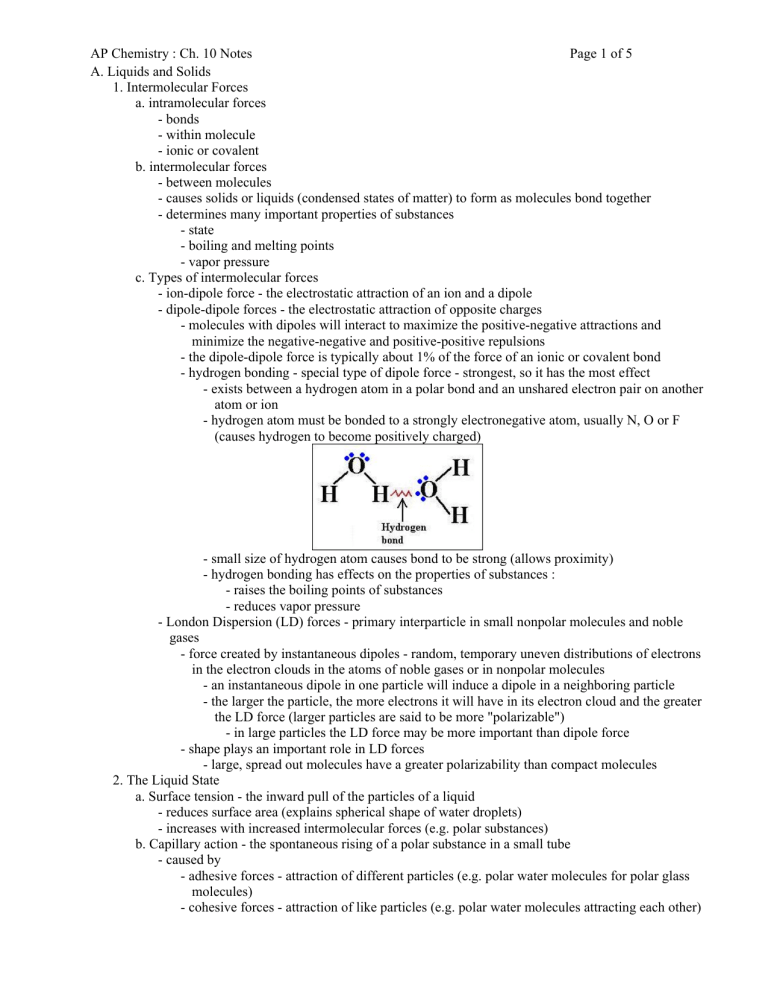
AP Chemistry : Ch. 10 Notes Page 1 of 5 A. Liquids and Solids 1. Intermolecular Forces a. intramolecular forces - bonds - within molecule - ionic or covalent b. intermolecular forces - between molecules - causes solids or liquids (condensed states of matter) to form as molecules bond together - determines many important properties of substances - state - boiling and melting points - vapor pressure c. Types of intermolecular forces - ion-dipole force - the electrostatic attraction of an ion and a dipole - dipole-dipole forces - the electrostatic attraction of opposite charges - molecules with dipoles will interact to maximize the positive-negative attractions and minimize the negative-negative and positive-positive repulsions - the dipole-dipole force is typically about 1% of the force of an ionic or covalent bond - hydrogen bonding - special type of dipole force - strongest, so it has the most effect - exists between a hydrogen atom in a polar bond and an unshared electron pair on another atom or ion - hydrogen atom must be bonded to a strongly electronegative atom, usually N, O or F (causes hydrogen to become positively charged) - small size of hydrogen atom causes bond to be strong (allows proximity) - hydrogen bonding has effects on the properties of substances : - raises the boiling points of substances - reduces vapor pressure - London Dispersion (LD) forces - primary interparticle in small nonpolar molecules and noble gases - force created by instantaneous dipoles - random, temporary uneven distributions of electrons in the electron clouds in the atoms of noble gases or in nonpolar molecules - an instantaneous dipole in one particle will induce a dipole in a neighboring particle - the larger the particle, the more electrons it will have in its electron cloud and the greater the LD force (larger particles are said to be more "polarizable") - in large particles the LD force may be more important than dipole force - shape plays an important role in LD forces - large, spread out molecules have a greater polarizability than compact molecules 2. The Liquid State a. Surface tension - the inward pull of the particles of a liquid - reduces surface area (explains spherical shape of water droplets) - increases with increased intermolecular forces (e.g. polar substances) b. Capillary action - the spontaneous rising of a polar substance in a small tube - caused by - adhesive forces - attraction of different particles (e.g. polar water molecules for polar glass molecules) - cohesive forces - attraction of like particles (e.g. polar water molecules attracting each other) AP Chemistry : Ch. 10 Notes Page 2 of 5 c. Viscosity - a measure of a liquid's resistance to flow - increases with increased intermolecular forces - increases with increased complexity of molecules - larger size allows particles to entangle (imagine pouring of boiled spaghetti vs boiled macaroni) 3. An Introduction to Structures and Types of Solids a. amorphous solids - lack an orderly internal arrangement (e.g. glass) - undefined melting point, soften gradually upon heating b. Crystalline solids - high degree if internal order - well defined melting point - lattice - 3-D array of points indicating the arrangement of the component particles (atoms, ions or molecules) of the crystal. - unit cell - smallest repeating unit of the lattice c. X-ray diffraction - method of determining lattice structure of crystals - x-rays are beamed at a crystal and then are reflect off of it in patterns that indicate the arrangement of the particles in the crystal d. Types of crystalline solids Atomic Solids Molecular Ionic Solids Solids Metallic Network Group 8A Particles at Metal atoms Nonmetal Group 8A Discrete Ions lattice points atoms atoms molecules Bonding type Delocalized Directional London Dipole-dipole Ionic covalent covalent dispersion and/or London leads to giant forces dispersion molecules forces Hard, brittle, Gases, low Soft, low Very hard, Properties Soft to hard, density melting points, high melting high melting low to high points, poor poor thermal points, often melting points, thermal and and electrical poor electrical excellent electrical conductors and thermal thermal and conductors conductors electrical conductors, malleable and ductile Examples Copper, iron, Diamond (C), Helium, neon, Methane Salts, NaCl, aluminum, graphite(C), argon etc. (CH4), sucrose CaSO4 etc. gold etc. silicon (SiO2) (C12H22O11) 4. Structure and Bonding in Metals a. Properties of metals : - thermal conductivity - electrical conductivity - malleability - ductility b. Metallic crystals - closest packing model - atoms are spheres which take up as little space as possible by packing as close as possible - aba arrangement - first and third layers are directly above each other - has a hexagonal unit cell - forms the hexagonal closest packing structure - abc arrangement - first and third layers are offset (every fourth layer lies directly below each other) - has a face-centered cubic unit cell - forms a cubic closest packing structure AP Chemistry : Ch. 10 Notes Page 3 of 5 - in both aba and abc arrangements each sphere has 12 equivalent nearest neighbors (called its coordination number)(6 in same layer, 3 in each layer above and below) - non-closest packing model - e.g. alkali metals - body-centered cubic unit cell - eight nearest neighbors (less dense) c. Metallic bonding - electron sea model - valence electrons are mobile amongst metallic cations - bonds formed by mutual attraction for these electrons(strong and nondirectional) - gives metals their properties (see a. above) - strength of bonding will increase with increased numbers of valence electrons - Group I metals - soft, with low melting points (only one valence electron) - Chromium - very hard with a high melting point (6 valence electrons) d. Metal alloys - a mixture of elements that have metallic properties - substitutional alloys - formed when atoms of the host metal are replaced by other metallic atoms of a similar size - e.g. sterling silver (93% silver, 7%copper), pewter (85% tin, 7% copper, 6% bismuth, 2% antimony) - interstitial alloy - formed when one metals has much smaller atoms that fit into the interstices of another atoms crystalline structure e.g. steel - carbon and iron alloy - mild steels - less than 0.2% carbon - nails, chains, cables - medium steels - 0.2-0.6% carbon - rails, structural beams - high-carbon steels - 0.6-1.5% carbon - springs, tools, knives etc. - alloy steels - have other elements besides Fe and C 5. Carbon and Silicon : Network Atomic Solids - atomic solids which form strong, directional bonds to form giant molecules - typically brittle and non-conducting a. Carbon - diamond - hard, nonconducting - carbon atoms are all in an interlocking tetrahedral arrangement - graphite - slippery, black, conductor - strong bonding within layers - weak bonding between layers b. Silicon - "silicon is to geology as carbon is to biology" - silica (empirical formula SiO2) - long chains of silicon and oxygen - make up much of the earth's crust - glass is silica that is heated above 1600 ºC and cooled quickly to form an amorphous solid - different glasses have different additives (e.g. borosilicate (like pyrex) glass has B2O3 added) - homogeneous - silicates- based on SiO4 tetrahedra - have a greater than 2:1 O/Si ratio - ceramics - made from clays which contain silicates - heterogeneous - semiconductors - silicon does allow some electrons to flow making it a semiconductor - conductivity of silicon can be increased by doping - n-type semiconductors - doped with an element which has one more valence electron than silicon, such as arsenic - p-type semiconductors - doped with an element that has one less valence electron than silicon, such as boron - p-n junction - junction between an n-type and a p-type semiconductor - allows solid state electronics 6. Molecular Solids - Lattice positions are occupied by molecules AP Chemistry : Ch. 10 Notes Page 4 of 5 - e.g. ice, sulfur (S8), phosphorus (P4) - strong covalent bonds within molecules, weak forces between molecules - intermolecular forces dependent on character of molecules (e.g. polar vs nonpolar, size) 7. Ionic Solids - stable with high melting points - held together by strong electrostatic forces of oppositely charged ions - structure can be explained by closest packing of spheres 8. Vapor Pressure and Changes of State a. Vaporization - change from liquid to gaseous state - endothermic process - enthalpy (heat) of vaporization (∆Hvap)- heat needed to vaporize one mole of a liquid at 1 atm b. Vapor pressure - dynamic equilibrium -state in a closed contained in which the rate of vaporization equals the rate of condensation - amounts of vapor and liquid are constant - no net change - vapor pressures are measured at equilibrium conditions - volatile liquids have high vapor pressures - vapor pressures increase with increased temperature c. Calculation of vapor pressure - Clasius-Clapeyron equation d. Sublimation - the change from the solid state directly to the gaseous state (e.g. dry ice) - endothermic e. Changes of State - heating curve for water - heat (enthalpy) of fusion - ∆Hfus - enthalpy change associated with the melting of one mole of a substance - change of state is a physical change - intermolecular bonds are broken (not intramolecular bonds) - melting and boiling points are determined by the vapor pressures of the solid and liquid states - at 0 ºC (and 1 atm - normal melting point) ice and liquid water have the same vapor pressure - at 100 ºC (and 1atm - normal boiling point) water vapor and atmospheric pressure are equal f. Supercooling - cooling of a liquid below the freezing point - occurs when the particles lack the internal arrangement to solidify at freezing point g. Superheating - heating of a liquid is raised above its boiling point - occurs when vapor bubbles fail to form - may suddenly boil violently when vapor bubbles do form 9. Phase diagrams - a representation of the states of a substance in relation to temperature and pressure. - represents a substance in a closed system and therefore may not truly represent a substance under all circumstances AP Chemistry : Ch. 10 Notes Page 5 of 5 d. b. a. c. a. Triple point (a.)- point at which the solid, liquid and vapor states all have the same vapor pressure and coexist b. Critical temperature - the temperature above which the vapor cannot be liquefied, regardless of the pressure applied c. Critical pressure - the pressure required to liquefy the vapor at the critical temperature d. Critical point (b.)- point at which the critical temperature and critical pressure coincide e. Slope of the solid-liquid boundary line - if negative - the liquid is more dense than the solid and vice versa f. Line ab is the vapor pressure curve of the liquid - represents equilibrium points between the liquid and its vapor at the various pressure and temperature combinations. g. Line ac is the solid-vapor pressure curve - represents equilibrium points between the solid and its vapor at the various pressure and temperature combinations. h. Line ad represents the change in melting point with changes in pressure - also represents equilibrium points between the solid and liquid states at the various pressure and temperature combinations.

